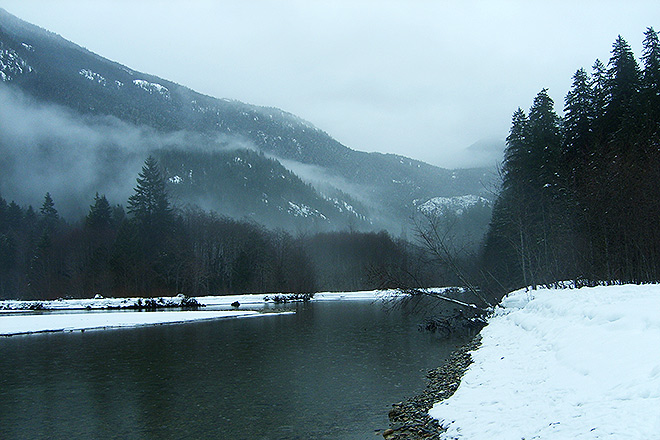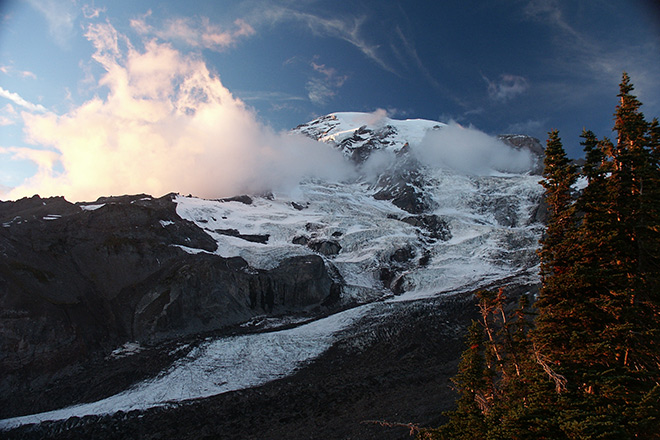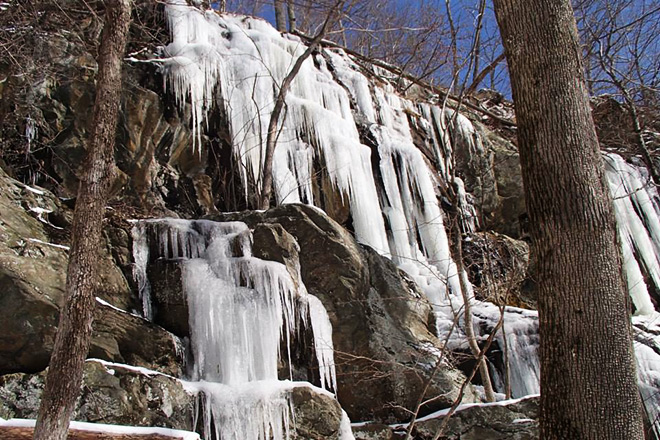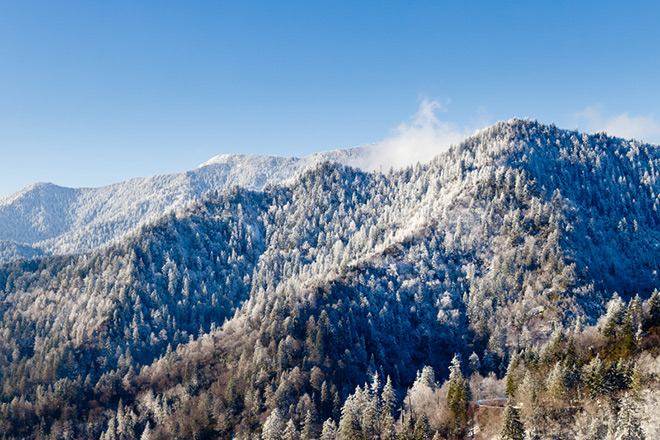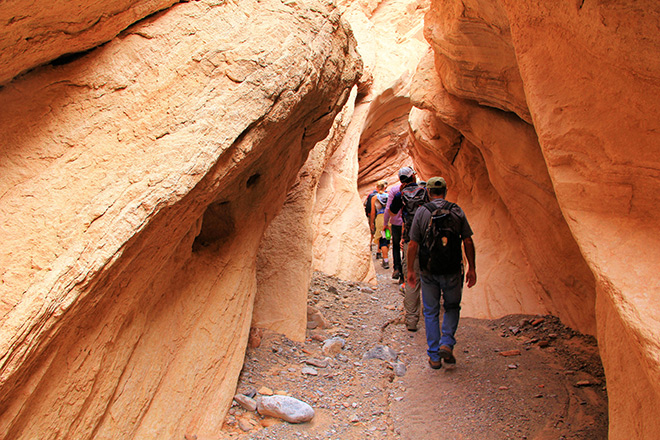The days are shorter and the weather is blustery — but that doesn't mean you need to stay indoors! NPCA has a few pointers and favorite places to explore during the winter months.
Though the cold weather and dark days of winter may discourage time outdoors, hiking during these months can be a fantastic and memorable experience. Crowds disappear, silence reigns, and landscapes take on a glittery and frost-covered splendor. Here are a few practical tips to help ensure a positive hiking experience for you and your loved ones.
- Plan ahead to ensure a safe and enjoyable time. Check the weather forecast, call the park for trail conditions, and understand the physical limitations of everyone in your group.
- Dress in lots of layers and pack a waterproof shell. Choose materials that dry quickly (not cotton) and be sure to shed layers to prevent yourself from getting too warm. When you take a break, your body will chill quickly (especially if your clothes get damp), so layer back up to maintain your temperature.
- Wear appropriate footwear for the trail. Are you hiking on a level, dry rail-to-trail? Or over a snow- or mud-covered trail? Pick shoes that fit well and have good traction. Waterproof shoes and/or gaiters are a plus. Consider bringing crampons if conditions could get icy.
- Pack sufficient supplies for changing weather and/or unexpected detours. Depending on the length of your hike, you’ll want to travel with plenty of water, snacks, extra layers (like gloves and a hat), a trail map, and a first aid kit. If you want to be really popular, pack a thermos of hot cocoa and a few plastic mugs. (Bonus tip: the best way to keep your hot cocoa extra hot is to temper your thermos with hot water. Add boiling water. Secure the top, and wait approximately 5 minutes to ensure the inside of the thermos is hot. Then, pour out the water and add your beverage of choice. The thermos will retain its heat much longer that way.)
- Tell others your plan. Leave your expected itinerary and estimated time of return with a loved one.
- Use the buddy system. While it’s always wise to hike with at least one other person, this is especially true in the winter months.
- Remember, it’s winter! Know that the mileage you can cover on a typical hiking day during the short winter days will be much lower than in the height of summer when you may have as much as 15 hours of daylight.
Eager to hit the trail? My colleagues at NPCA recommend these six hikes as a few of their favorites for enjoying the winter weather.
1. Ross Lake National Recreation Area, Washington
Recommended by: Shane Farnor, online advocacy manager Trail: Thunder Creek Trail Highlight: towering old-growth trees and blue waters Distance (one-way): from 2 miles (to the first bridge crossing of Thunder Creek) up to 19.6 miles (to Park Creek Pass) Starting point: Amphitheater of Colonial Creek Campground (mile 130/Diablo Lake, off State Route 20)
Located between the north and south units of North Cascades National Park, this beautiful trail follows an arm of Diablo Lake before continuing along the glacier-fed Thunder Creek. Take note of the turquoise color of the water, a product of “rock flour” which consists of tiny particles of bedrock that have been dug out and pulverized by the movement of glaciers (though this phenomenon is more pronounced in the spring when more water runs off from the glaciers). Towering around you and scenting the air as you walk are ancient, lichen-covered cedar and fir trees. Shane says, simply, “It’s a magical trail.” Need we say more?
Note: Depending on the snow cover, you may want to opt for snowshoes rather than boots.
2. Mount Rainier National Park, Washington
Recommended by: David Graves, Northwest program manager Trail: Reflection Lakes Highlight: inspiring views Distance (round-trip): 5.5 miles Starting point: Narada Falls parking lot
While the snow- and ice-covered lakes may preclude the reflections in the hike’s name, David promises this trail is “a classic Mt. Rainier winter experience” that offers “breathtaking views of the mountain.” From the parking lot, take the path that circles into the forest and up to the road. When you see a sign, opt for the avalanche-free route to the lakes (the High Lakes Trail). Part of this hike involves a sometimes-steep climb up over the saddle of Mazama Ridge. You’ll then drop into a meadow beside the lakes. On a clear day, your camera will hardly do this trail justice.
Note: Snowshoeing is recommended. The park concessionaire rents snowshoes; check at the Longmire General Store for availability and rates.
3. Shenandoah National Park, Virginia
Recommended by: Ben Sander, travel program manager Trail: Whiteoak Canyon/Cedar Run Loop Highlight: frozen waterfalls Distance (round-trip): 7.9 miles if you do the loop, or approx. 4 miles if you go to Upper Whiteoak Falls and back Starting point: Whiteoak Canyon Parking lot (off Route 600)
Shenandoah National Park boasts some beautiful trails and spectacular scenery at all times of the year. If you want to beat the heat and the crowds, and if you have a soft-spot for “gorgeous, frozen waterfalls,” Ben says this challenging loop hike may be for you. From the Whiteoak Canyon parking lot, travel counter-clockwise following the Whiteoak Canyon Trail past a series of waterfalls that appear stuck in time, dangling like icy daggers. To complete the loop, take the Whiteoak Fire Road, bear left onto the marked horse trail, and continue on to the Cedar Run Trail back to your car. While all that slick rock and carved ice makes for one incredible hike, exercise caution. You may find Yaktrax (or a similar traction device) a necessity.
4. Great Smoky Mountains, Tennessee
Recommended by: Don Barger, senior director, Southeast Regional Office Trail: Alum Cave Bluff Trail to Mt. LeConte Highlight: mountain-top views Distance (round-trip): 11 miles Starting point: Alum Cave trailhead (off Newfound Gap Road)
Located south of Gatlinburg, Don sings this trail’s praises, stating it’s a “winter wonderland.” At its terminus, the summit of Mt. LeConte at over 6,500 feet above sea level awaits. If you’d guess that most of this trail ascends, you’d be right. The views and pit stops along the way, however, will take your breath away, even if the thin air doesn’t. You’ll pass Arch Rock, have a view of the Eye of the Needle from Inspiration Point, and be able to duck into Alum Cave–which is actually more of a rocky alcove than a true cave. As the climb continues, be careful of your footing, especially in the sections with cable handholds. About a half mile before you hit the true summit of the mountain, you’ll find LeConte Lodge — which, like the cave, is less a lodge than a series of charming, rustic cabins. Visit the summit, the third-highest in the park, and then continue for a quarter-mile to Myrtle Point for a fantastic view of the mountains and the Tennessee Valley. Due to icy conditions on the trail, park staff recommend sturdy footwear and crampons during the winter season.
Park officials will conduct maintenance on this trail over the next several years, starting in May 2015. Check the park website before you go to make sure it won’t affect your hike.
Note: If you want to literally unplug for a night and sleep in one of the LeConte Lodge structures, be prepared to book well in advance, as these cabins fill up quickly.
5. Muddy Mountains Wilderness Area in Lake Mead National Recreation Area, Nevada
Recommended by: Lynn Davis, Las Vegas senior program manager Trail: Anniversary Narrows Highlight: beautiful slot canyon Distance (round-trip): 5-6 miles Starting point: Road 94A (Take Northshore Road to mile marker 16 and go north on Callville Wash Road/Road 94 and then take a left onto Road 94A.)
While this trail requires more caution than others we’ve listed (see note below), Lynn says this slot canyon located about an hour outside of Las Vegas is a “must-see.” With its vibrant orange walls, narrow twists and turns, and beautifully layered rocks that serve as a hands-on geology lesson, Anniversary Narrows leaves little to be desired. And, in an area of the country typified by extreme heat, the winter season is an ideal time to plan a visit. Start out in long sleeves, and you might just end up in short sleeves by hike’s end.
Note: Depending on where you park, you may need a 4-wheel drive vehicle, or at least a vehicle with high clearance. There are some active mining operations in the area, so take care to avoid them. Finally, as with most canyons, do not plan a hike in this area if flash floods or thunderstorms are in the forecast.
6. Mojave National Preserve, California
Recommended by: Lynn Davis, Las Vegas senior program manager Trail: Kelso Sand Dunes Highlight: mesmerizing mountains of sand Distance: With no clear trail markers, your hike can be as long or as short as you like. Starting point: Kelso Dunes Trailhead off Kelbaker Road
Some of the highest and vastest dunes in our country, measuring in at nearly 700 feet and over 45 square miles, the Kelso Sand dunes are a natural marvel. With no defined trails, these dunes are yours to explore. Maybe you’ll see a mirage, maybe you’ll hear the sands sing beneath your feet, or maybe you’ll regress to childhood and embrace the winter by flopping onto your back and making your very own “sand angel.” No matter your purpose or destination, Lynn assures us that hiking among these beautiful and desolate dunes is sure to leave you speechless.
If you go: Be sure to bring a compass or GPS device, especially if you are unaccustomed to hiking through dunes. It’s easy to get disoriented in the middle of all that sand.
About the author
-
 Katherine DeGroff Associate and Online Editor
Katherine DeGroff Associate and Online EditorKatherine is the associate editor of National Parks magazine. Before joining NPCA, Katherine monitored easements at land trusts in Virginia and New Mexico, encouraged bear-aware behavior at Grand Teton National Park, and served as a naturalist for a small environmental education organization in the heart of the Colorado Rockies.
